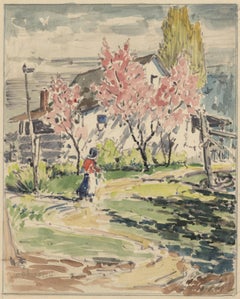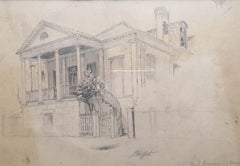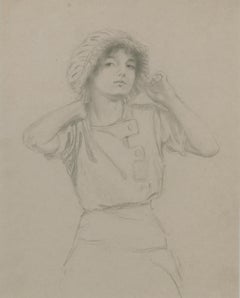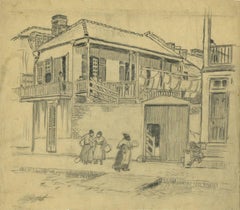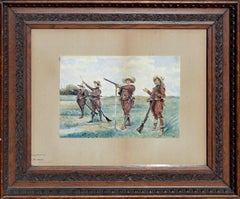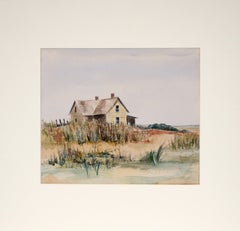Louis Oscar Griffith Drawings and Watercolor Paintings
to
5
2
3
2
5
Overall Height
to
Overall Width
to
4
1
3
3
2
1
1
1
1
1
4
2
2
15
707
412
288
228
3
3
2
2
1
Artist: Louis Oscar Griffith
Spring Landscape with house and figure
By Louis Oscar Griffith
Located in Fairlawn, OH
Spring Landscape with house and figure
A preliminary watercolor for a color aquatint, illustrated on line, title unknown
Signed lower left in block letters (see photo)
Watercolor and...
Category
1920s American Impressionist Louis Oscar Griffith Drawings and Watercolor Paintings
Materials
Watercolor
Standing Lincoln: The Man, Lincoln Park, Illinois
By Louis Oscar Griffith
Located in Fairlawn, OH
Standing Lincoln: The Man, Lincoln Park, Illinois
Watercolor and graphite on paper , c. 1895
Signed in script lower right (see photo)
The scene depicts the Augustus Saint-Gaudens bro...
Category
1890s American Impressionist Louis Oscar Griffith Drawings and Watercolor Paintings
Materials
Watercolor
Beauregard House, New Orleans
By Louis Oscar Griffith
Located in New Orleans, LA
Louis Oscar Griffith (1875-1956) was an American painter known for his etchings, paintings, and aquatints of landscapes, especially scenes of Brown County, Indiana, New Orleans, LA and Texas. Griffith was born in Indiana in 1875 but later moved to Dallas, TX with his family. As a teen, he took art lessons with acclaimed landscape artist, Frank Reaugh...
Category
1910s Impressionist Louis Oscar Griffith Drawings and Watercolor Paintings
Materials
Paper, Graphite
Carolyn (Arms raised to her head)
By Louis Oscar Griffith
Located in Fairlawn, OH
Carolyn (Arms raised to her head)
Graphite on laid paper
Unsigned
Provenance: Estate of the artist
by descent to his Grandson
Depicts the artist's wife Carolyn.
Most probably created in Nashville, Indiana
Related to the painting entitled "Maiden" in the Haan Museum, Lafayette, IN (see photo)
Condition: Excellent
Archival framing with TruVue Conservation Clear glass
Image size: 10 3/4 x 8 1/2 inches
Frame size: 18 7/8 x 16 inches
Louis Oscar Griffith
(1875-1956)
Born in Greencastle, Indiana, Griffith grew up in Dallas, Texas where Texas artist and teacher Charles Franklin Reaugh recognized young “Griff’s” artistic talent. At age 18, Griffith moved to St. Louis where he attended the St. Louis School of Fine Arts.
In 1895, he moved to Chicago where he worked making color prints for the firm Barnes and Crosby. He attended the Art Institute of Chicago and during a brief stay in New York, the National Academy of Design. A successful commercial artist with a studio in the Chicago Loop, Griffith was a member and president of the Chicago Palette and Chisel Club.
He made his first trip to Brown County...
Category
1920s Abstract Impressionist Louis Oscar Griffith Drawings and Watercolor Paintings
Materials
Graphite
Preliminary Drawing for the color aquatint "Street Gossip"
By Louis Oscar Griffith
Located in Fairlawn, OH
Preliminary Drawing for the color aquatint "Street Gossip"
Signed by the artist in pencil lower left
Graphite on tracing paper, 1916-1917
An impre...
Category
1910s American Impressionist Louis Oscar Griffith Drawings and Watercolor Paintings
Materials
Graphite
Related Items
"Arquebusiers En Manoeuvre", After Marchetti
Located in Soquel, CA
Figurative landscape of four infantrymen in formation with their long arquebus guns by Adolphe Ancker (Dutch, 19th Century), after Marchetti. Signed and dated "Adolph Ancker 1888" lo...
Category
1880s American Impressionist Louis Oscar Griffith Drawings and Watercolor Paintings
Materials
Paper, Watercolor, Pencil
Farmhouse by the Sea - Original Watercolor on Paper
Located in Soquel, CA
Farmhouse by the Sea - Original Watercolor on Paper
Tranquil landscape of a seaside farmhouse on the sand surrounded by coastal plants, in soft neutral watercolors. A distant ocean s...
Category
Late 20th Century American Impressionist Louis Oscar Griffith Drawings and Watercolor Paintings
Materials
Paper, Watercolor
"Study off Newport, Rhode Island" John Singer Sargent Drawing, Impressionism
By John Singer Sargent
Located in New York, NY
John Singer Sargent
Study off Newport, Rhode Island, 1876
Signed in pencil "JS265A" lower left
Pencil on paper
5 x 10 inches
Provenance:
Estate of the artist
Grand Central Art Galleries, New York, 1959
Mr. William H. Bender Jr
Sotheby's New York, September 19, 1987
Private Collection 1987-2000
Mark Borghi Fine Art Inc., circa 2002
Private Collection (acquired from the above), New York
Recognized as the leading portraitist in England and the United States at the turn of the century, John Singer Sargent was acclaimed for his elegant and very stylish depictions of high society. Known for his technical precocity, he shunned traditional academic precepts in favor of a modern approach towards technique, color and form, thereby making his own special contribution to the history of grand manner portraiture.
A true cosmopolite, he was also a painter of plein air landscapes and genre scenes, drawing his subjects from such diverse locales as England, France, Italy and Switzerland. In so doing, Sargent also played a vital role in the history of British and American Impressionism.
Sargent was born in Florence in 1856. He was the first child of Dr. Fitzwilliam Sargent, a surgeon from an old New England family, and Mary Newbold Singer, the daughter of a Philadelphia merchant. His parents were among the many prosperous Americans who adopted an expatriate lifestyle during the later nineteenth century. Indeed, Sargent's family traveled constantly throughout the Continent and in England, a mode of living that enriched Sargent both culturally and socially. He ultimately became fluent in French, Italian and German, in addition to English.
Having developed an interest in drawing as a boy, Sargent received his earliest formal instruction in Rome in 1869, where he was taught by the German-American landscape painter Carl Welsch. Following this, he attended the Accademia di Belle Arti in Florence during 1873-74.
In the spring of 1874, Sargent's family moved to Paris, enabling him to continue his training there. He soon entered the studio of Charles-Emile-Auguste Carolus-Duran. In contrast to most French academic painters, Carolus-Duran taught his students to paint directly on the canvas, capturing the essence of his subject through relaxed brushwork, a tonal palette and strong chiaroscuro. Although Sargent also spent four years studying drawing under Léon Bonnat at the Ecole des Beaux-Arts, it was Carolus-Duran's approach that would form the aesthetic basis of his style.
Upon his teacher's advice, Sargent also traveled to Spain and Holland to study the work of old master painters such as Diego Velázquez and Frans Hals, both of whom also employed deft, fluid techniques.
In 1876, Sargent made his first visit to the United States, claiming his American citizenship and visiting the Philadelphia Centennial Exposition. One year later, he spent the summer in Cancale, in France's Brittany region, where he painted outdoors, applying Carolus-Duran's strategies to portrayals of fishing folk on sunlit beaches. His reputation in Paris was established in 1878 when his Oyster Gatherers of Cancale (1878; Corcoran Gallery of Art, Washington, D.C.) won an Honorable Mention at that year's Salon.
During the early 1880s, Sargent began making painting trips abroad, working in Venice in 1880 and 1882, where he painted street scenes and interiors notable for their brilliant play of light and shadow. He also embarked on what would be a lucrative career as a portraitist, producing such well known works as The Daughters of Edward Darley Boit (1882; Museum of Fine Arts, Boston).
His early commissions also included an image of Madame Pierre Gautreau. A renowned beauty and member of Parisian society, Madame Gautreau was known for her bold, unorthodox approach towards fashion. In her portrait, entitled "Madame X" (1884; Metropolitan Museum of Art, New York), Sargent effectively captured her distinctive aura. However, his daring realism, coupled with fact that he portrayed a diamond shoulder strap falling off one of her shoulders, caused such an uproar that his career in France was seriously compromised.
As a result of the controversy surrounding "Madame X,"Sargent left Paris in 1886, settling permanently in London. He subsequently flourished in the English capital, becoming the leading portrait painter to the upper classes. Those who shared Sargent's sense of refinement and sophistication, as well as his international viewpoint, were especially drawn to his fashionable French style.
In addition to patronage from such prominent British families as the Wertheimers and the Marlboroughs, Sargent received an equal number of American commissions, many of them secured by artists and architects he had met during his student days in Paris, among them painters J. Carroll Beckwith and Julian Alden Weir and architect Stanford White. On a painting tour to America during 1887-1888, he portrayed members of notable families from Boston and New York, including Mrs. Jacob Wendell and Elizabeth Allen...
Category
1870s Impressionist Louis Oscar Griffith Drawings and Watercolor Paintings
Materials
Paper, Pencil, Graphite
Garland Studies I
By John Singer Sargent
Located in New York, NY
Image dimensions: 7 ¼ x 10 ½ inches
Framed dimensions: 16 ½ x 20 inches
To produce his murals, Sargent painted monumental canvases in his studios in London and Boston, adhering them...
Category
1920s American Impressionist Louis Oscar Griffith Drawings and Watercolor Paintings
Materials
Paper, Pencil
"Train Station, " Max Kuehne, Industrial City Scene, American Impressionism
By Max Kuehne
Located in New York, NY
Max Kuehne (1880 - 1968)
Train Station, circa 1910
Watercolor on paper
8 1/4 x 10 1/4 inches
Signed lower right
Provenance:
Private Collection, Illinois
Max Kuehne was born in Halle, Germany on November 7, 1880. During his adolescence the family immigrated to America and settled in Flushing, New York. As a young man, Max was active in rowing events, bicycle racing, swimming and sailing. After experimenting with various occupations, Kuehne decided to study art, which led him to William Merritt Chase's famous school in New York; he was trained by Chase himself, then by Kenneth Hayes Miller. Chase was at the peak of his career, and his portraits were especially in demand. Kuehne would have profited from Chase's invaluable lessons in technique, as well as his inspirational personality. Miller, only four years older than Kuehne, was another of the many artists to benefit from Chase's teachings. Even though Miller still would have been under the spell of Chase upon Kuehne's arrival, he was already experimenting with an aestheticism that went beyond Chase's realism and virtuosity of the brush. Later Miller developed a style dependent upon volumetric figures that recall Italian Renaissance prototypes.
Kuehne moved from Miller to Robert Henri in 1909. Rockwell Kent, who also studied under Chase, Miller, and Henri, expressed what he felt were their respective contributions: "As Chase had taught us to use our eyes, and Henri to enlist our hearts, Miller called on us to use our heads." (Rockwell Kent, It's Me O Lord: The Autobiography of Rockwell Kent. New York: Dodd, Mead and Co., 1955, p. 83). Henri prompted Kuehne to search out the unvarnished realities of urban living; a notable portion of Henri's stylistic formula was incorporated into his work.
Having received such a thorough foundation in art, Kuehne spent a year in Europe's major art museums to study techniques of the old masters. His son Richard named Ernest Lawson as one of Max Kuehne's European traveling companions. In 1911 Kuehne moved to New York where he maintained a studio and painted everyday scenes around him, using the rather Manet-like, dark palette of Henri.
A trip to Gloucester during the following summer engendered a brighter palette. In the words of Gallatin (1924, p. 60), during that summer Kuehne "executed some of his most successful pictures, paintings full of sunlight . . . revealing the fact that he was becoming a colorist of considerable distinction." Kuehne was away in England the year of the Armory Show (1913), where he worked on powerful, painterly seascapes on the rocky shores of Cornwall. Possibly inspired by Henri - who had discovered Madrid in 1900 then took classes there in 1906, 1908 and 1912 - Kuehne visited Spain in 1914; in all, he would spend three years there, maintaining a studio in Granada. He developed his own impressionism and a greater simplicity while in Spain, under the influence of the brilliant Mediterranean light. George Bellows convinced Kuehne to spend the summer of 1919 in Rockport, Maine (near Camden). The influence of Bellows was more than casual; he would have intensified Kuehne's commitment to paint life "in the raw" around him.
After another brief trip to Spain in 1920, Kuehne went to the other Rockport (Cape Ann, Massachusetts) where he was accepted as a member of the vigorous art colony, spearheaded by Aldro T. Hibbard. Rockport's picturesque ambiance fulfilled the needs of an artist-sailor: as a writer in the Gloucester Daily Times explained, "Max Kuehne came to Rockport to paint, but he stayed to sail." The 1920s was a boom decade for Cape Ann, as it was for the rest of the nation. Kuehne's studio in Rockport was formerly occupied by Jonas Lie.
Kuehne spent the summer of 1923 in Paris, where in July, André Breton started a brawl as the curtain went up on a play by his rival Tristan Tzara; the event signified the demise of the Dada movement. Kuehne could not relate to this avant-garde art but was apparently influenced by more traditional painters — the Fauves, Nabis, and painters such as Bonnard. Gallatin perceived a looser handling and more brilliant color in the pictures Kuehne brought back to the States in the fall. In 1926, Kuehne won the First Honorable Mention at the Carnegie Institute, and he re-exhibited there, for example, in 1937 (Before the Wind). Besides painting, Kuehne did sculpture, decorative screens, and furniture work with carved and gilded molding. In addition, he designed and carved his own frames, and John Taylor Adams encouraged Kuehne to execute etchings. Through his talents in all these media he was able to survive the Depression, and during the 1940s and 1950s these activities almost eclipsed his easel painting. In later years, Kuehne's landscapes and still-lifes show the influence of Cézanne and Bonnard, and his style changed radically.
Max Kuehne died in 1968. He exhibited his work at the National Academy of Design, the Art Institute of Chicago, the Carnegie Institute in Pittsburgh, the Memorial Art Gallery of the University of Rochester, and in various New York City galleries. Kuehne's works are in the following public collections: the Detroit Institute of Arts (Marine Headland), the Whitney Museum (Diamond Hill...
Category
1910s American Impressionist Louis Oscar Griffith Drawings and Watercolor Paintings
Materials
Paper, Watercolor
" Portrait d'Homme " . "Portait of a man " original drawing. certified .
By Jean Cocteau
Located in CANNES, FR
" portrait d'homme en buste ". " portrait of a man " is an original drawing , graphite on tracing paper.
this drawing was executed by Jean Cocteau in 1931 during a stay in the clin...
Category
1930s Art Deco Louis Oscar Griffith Drawings and Watercolor Paintings
Materials
Graphite
Morning Near Arizona, 1880s Summer Southwestern Desert Landscape Drawing
By George Elbert Burr
Located in Denver, CO
Morning Near Arizona, (Desert Landscape) is an original color pencil drawing from 1888 by George Elbert Burr (1859-1939). Portrays a spring/summer landscape with a tree and fauna, cl...
Category
1880s American Impressionist Louis Oscar Griffith Drawings and Watercolor Paintings
Materials
Archival Paper, Color Pencil
H 17 in W 20.25 in D 1 in
Albert Lorey Groll, American 1866-1952 Pencil sketch.
By Albert Groll
Located in Hallowell, ME
6.5" x 8" pencil on paper. Crows in a landscape. In custom mat from Kennedy Galleries, approx 14" x 20"Born in New York City, Albert Lorey Groll became a much admired, successful western desert...
Category
Early 20th Century American Impressionist Louis Oscar Griffith Drawings and Watercolor Paintings
Materials
Pencil
"I'll strengthen you "
Located in VÉNISSIEUX, FR
I enjoy working on impressionist artworks with an expressive touch. This artwork makes part of one of my favorite series dedicated to women whom I always want to represent as strong,...
Category
2010s Abstract Impressionist Louis Oscar Griffith Drawings and Watercolor Paintings
Materials
Oil
"Old Russell House, " Charles Marion Russell, Western American Drawing
By Charles Marion Russell
Located in New York, NY
Charles Marion Russell (1864 - 1926)
Old Russell House
Pencil on paper
3 1/2 x 6 1/2 inches
Provenance:
Kennedy Galleries, New York
Raydon Galleries, ...
Category
Late 19th Century American Impressionist Louis Oscar Griffith Drawings and Watercolor Paintings
Materials
Paper, Pencil
CASTLE ROCK - SANTA MONICA, CA
Located in Santa Monica, CA
THOMAS HILL McKAY (1875-1941)
ARCH ROCK - SANTA MONICA, CA c. 1925-30
Watercolor, signed lower right. Sheet 14 x 18 inches.. Additional full sheet study on verso.. Generally good c...
Category
1920s American Impressionist Louis Oscar Griffith Drawings and Watercolor Paintings
Materials
Watercolor
"I am here for you"
Located in VÉNISSIEUX, FR
I enjoy working on impressionist artworks with an expressive touch. This artwork makes part of one of my favorite series dedicated to women whom I always want to represent as strong,...
Category
2010s Abstract Impressionist Louis Oscar Griffith Drawings and Watercolor Paintings
Materials
Oil
Louis Oscar Griffith drawings and watercolor paintings for sale on 1stDibs.
Find a wide variety of authentic Louis Oscar Griffith drawings and watercolor paintings available for sale on 1stDibs. You can also browse by medium to find art by Louis Oscar Griffith in graphite, pencil, paint and more. Much of the original work by this artist or collective was created during the 20th century and is mostly associated with the Impressionist style. Not every interior allows for large Louis Oscar Griffith drawings and watercolor paintings, so small editions measuring 8 inches across are available. Customers who are interested in this artist might also find the work of Reynolds Beal, Albert Van Nesse Greene, and James March Phillips. Louis Oscar Griffith drawings and watercolor paintings prices can differ depending upon medium, time period and other attributes. On 1stDibs, the price for these items starts at $1,500 and tops out at $3,000, while the average work can sell for $1,750.
